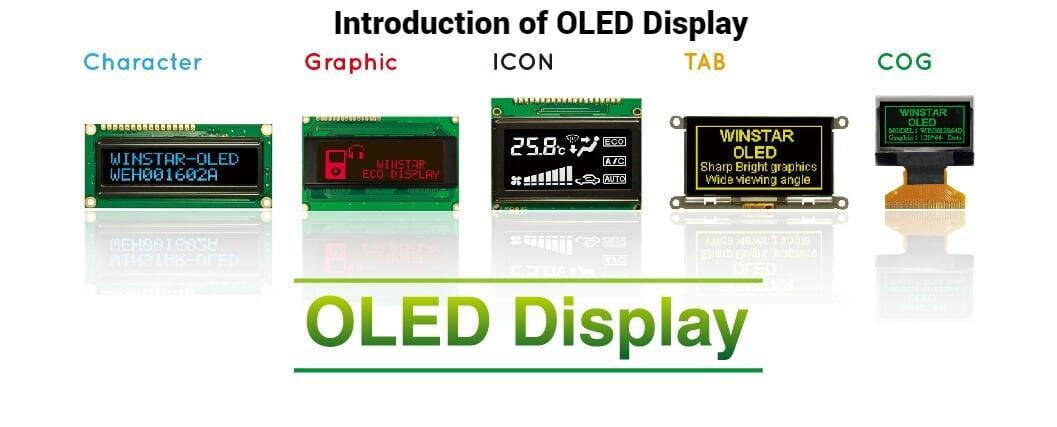
OLED (Organic light emitting diodes) are a type of display technology that is rapidly gaining popularity in a variety of applications including embedded systems, IOT, smart wearables, smartphones. OLED displays offer many advantages over LCD displays. OLED has revolutionized the way we interact with screens on various devices. In this blog, we'll discuss OLED displays, their advantages, and applications.
What is OLED?
The acronym ‘OLED’ stands for Organic Light-Emitting Diode. OLED is a technology that uses LEDs in which the light is produced by organic molecules. OLED displays are made by placing a series of thin organic films between two conductors. When an electrical current is applied, a bright light is emitted.
OLEDs make use of emissive displays, allowing each pixel to be individually controlled and emit its light, in contrast to LCDs that work on a backlighting unit. This feature of OLED displays results in excellent image quality, vivid colors, rapid motion response, and high contrast. Another advantage of the uncomplicated design of OLEDs, this makes it easy to produce flexible and transparent displays.
Advantages of OLED Displays
Flexible and Thin: OLED displays can be made to be flexible and thin, which makes them ideal for applications such as wearables and curved and small displays.
Faster Response Times: OLED pixels have faster response times than LCD pixels, reducing motion blur in fast-paced scenes, which is especially beneficial for gaming and sports enthusiasts.
Wider Viewing Angles: OLED displays maintain their picture quality at wider viewing angles, ensuring a consistent visual experience for viewers from various positions.
Improved Image Quality: OLED displays offer superior contrast, brightness, and viewing angles compared to LCD displays. This is because OLED displays emit their own light, rather than relying on a backlight.
Thinner and Lighter: OLED displays are significantly thinner and lighter than LCD displays. This is because OLED displays do not require a backlight or polarizer, which are two of the major components of LCD displays.
Lower Power Consumption: OLED displays consume significantly less power than LCD displays. This is because OLED displays only emit light when they are being activated, which means that they can be turned off when they are not being used.
Applications of OLED Displays
Consumer Electronics: OLED displays are commonly used in smartphones, tablets, laptops, and smartwatches, enhancing the user experience with vibrant colors and sharp images.
Television and Monitors: High definition televisions and monitors use OLED technology to deliver superior picture quality, captivating viewers with lifelike images.
Automotive: OLED displays are increasingly finding their way into the automotive industry, dashboards, infotainment systems, and rear lights, providing both aesthetic appeal and functionality.
Lighting: OLEDs are also used in lighting solutions, offering soft, diffused lighting that can be taken use into various designs and shapes.
Lets See Some Features of Available OLED Displays from Campus Component
1. 0.96 inch OLED Display -AR-826-D
0.96 inch OLED display Features:-
Display Type: OLED
Dot Matrix: 128x64
Dot Size: 0.154mm * 0.154mm
Dot Pitch: 0.17 * 0.17 mm
Aperture Rate : 78%
Active Area : 21.744 * 10.864mm
Driver IC: SSD1306
2. 2.8" DWIN Smart Capacitive Touch Screen Display DMG32240C028_03WTC- LC-2849-D
The DMG32240C028 2.8" Smart Capacitive Touchscreen Display can easily be interfaced with microcontrollers & controller boards like Arduino Uno, Arduino Nano, Arduino Mega, ESP8266, ESP32, PIC Microcontrollers, 8051 family of microcontrollers, etc.
2.8” Smart Capacitive Touch screen Display DMG32240C028_03WTC Features:-
Size: 2.8"
Touch Type: Capacitive
Resolution: 320x240
Grade: Commercial
Color: 262K Colors; 18 Bit
Dimensions: 85.2 mm (W) x 55.6 mm (H) x 11.65 mm (T)
Backlight: LED
Brightness: 200 nit
Operating Voltage: 5 Volts
Operating Current: 40ma to 105ma
Working Temperature: -20 to 70°C
3. OLED 0.91 Inches 128X32-LC-585-D
OLED 0.91 inches 128*32 – LC – 585 – D Features:-
0.91inch small form factor
128x32 high resolution
I2C interface, requires only two signal pins
Driver: 1306
Interface: I2C
Display color: White
Resolution: 128x32
Viewing angle: >160°
Operating voltage: 3.3V / 5V
Conclusion
OLED display is a promising new display technology that offers a number of advantages over traditional LCD displays. As OLED technology continues to develop and more applications come in, it's become easier for developers to rely on an OLED display because of features offered at lower price.
If you are building an IOT device and looking for OLED display from brands such as Sinda, Nextion, Abilton to incorporate in your project then reach out to us at Campus Component today!
